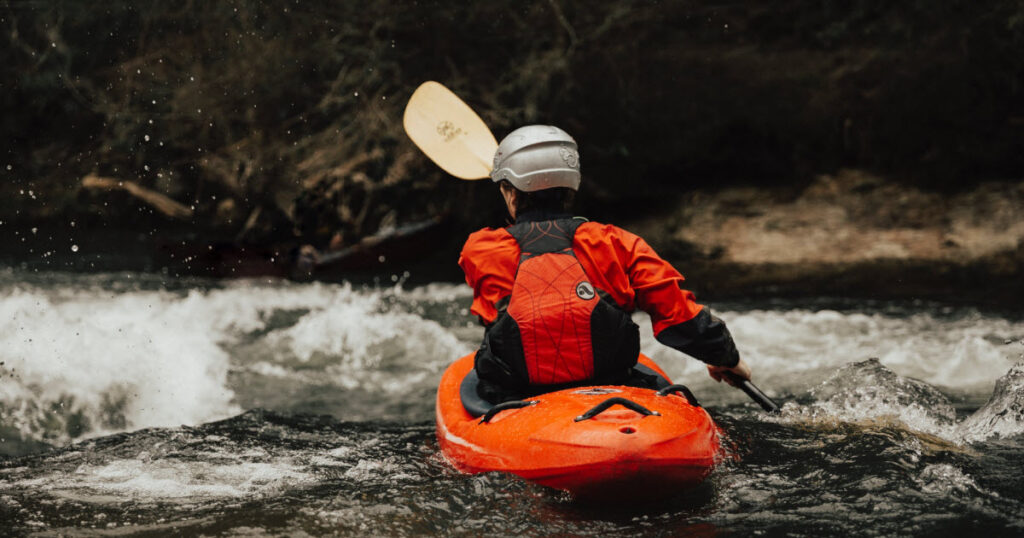Are you a first-time kayaker? Or are you perhaps thinking about letting your kids take part in a kayaking trip? If so, you are probably wondering how hazardous the activity can be and what you can do to get prepared to mitigate risks wherever possible. Here we will answer the frequently asked question: is kayaking dangerous?
Like any other activity on the water, kayaking carries inherent risks. The risk of submersion and not being able to get out of the water is a danger if you don’t know what you’re doing and don’t take all the necessary safety precautions. Remember that kayaking on more challenging types of water, such as white water, should be reserved for very experienced kayakers.
Let’s go over some tips for how to keep yourself safe on your kayaking adventures.
Always Wear a Life Jacket
Everyone taking part in kayaking must always wear a PFD (personal flotation device or life jacket). Make sure you get a life jacket that is specifically designed to be worn while kayaking, so that you will find it comfortable and not be tempted to take it off at any point (I have the Yukon Sport model from Amazon).
Not having an appropriate PFD can make kayaking dangerous.
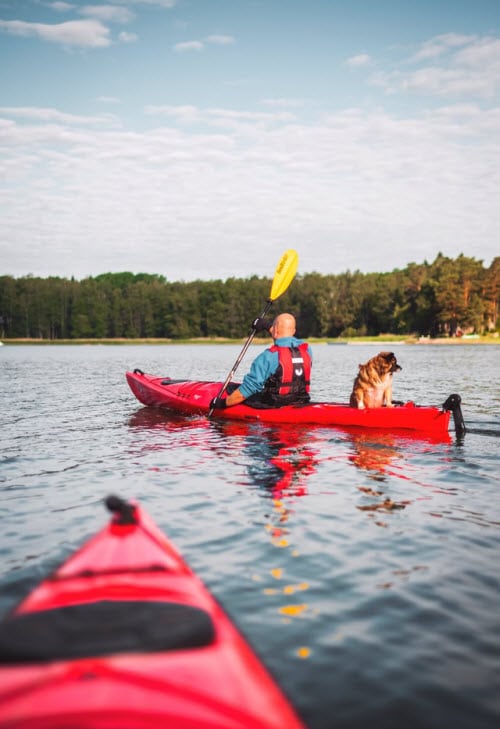
The PFD you buy and wear should be properly rated for your weight and size. Get a professional to do the fitting and get advice on how to wear your PFD correctly.
A general recommendation is that you should have someone verify how your PFD fits by placing two fingers beneath each of the shoulder straps and briskly lifting it up. When this is done, the PFD should not be able to get anywhere past your ears.
Dress Appropriately
Always keep the danger of falling into the water and getting submerged in mind when getting dressed for a kayaking trip.
Falling into cold water quickly turns into a dangerous situation because of the danger of hypothermia. If you’ll be kayaking on cooler or cold water, be more careful when choosing what you will wear. In colder temperatures, it becomes even more important to never kayak alone and to stay close to the shore.
Stay Within Your Skill Level
Your skill level is the most important factor to consider when choosing a location for kayaking. Kayaking is a sport that is only as hard as you make it.
If you’re a beginner or only have limited kayaking experience, then make sure that the area is protected from waves and winds. The place you choose should make landing and launching easy. It should also have lots of spots where you can get ashore. As a beginner, going too far away from shore can make kayaking dangerous.
Make sure there is the minimal possible amount of existing boat traffic. Some of the best places for beginners to go kayaking include peaceful lakes and tranquil bays.
If you must practice kayaking on rivers, avoid any place with any sort of visible or apparent current.
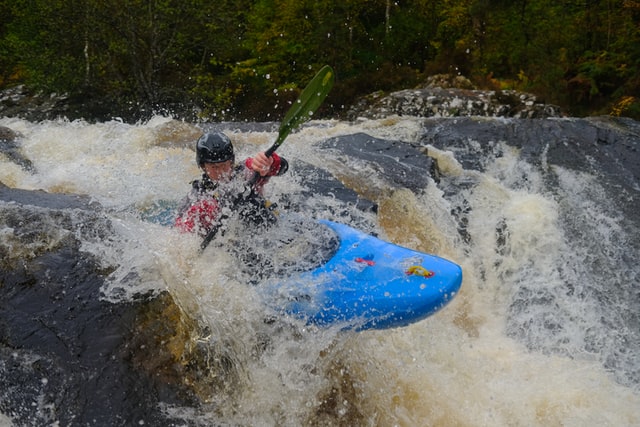
Areas other than ones fitting these descriptions are appropriate only for experienced kayakers. You must be prepared to deal with the potentially dangerous situations.
These situations can quickly develop when they are so far away from shore that they could not swim to the shore, or in situations with waves and wind.
If you one day want to go into advanced environments, then you must take kayaking training for the kind of water you want to tackle. Learn water rescue skills and make sure you go kayaking with at least one other person who has this kind of training.
Know How to Re-Enter Your Kayak
Spend time practicing re-entering your kayak.
This is important, as if you don’t know how to do this quickly and effectively if you fall out of the kayak or it capsizes on the water, you will be at risk. At the very least, you will find your new activity a very difficult one!
The fact that you’ll need to re-enter your kayak is the reason why you should probably go for a sit-on-top kayak rather than a sit-inside one. One reason for this is the fact that you will find re-entering a sit-on-top kayak to be much easier than a sit-inside model.
A sit-inside kayak model is also much more likely to become swamped with water. This is especially a problem if a sit-inside kayak doesn’t have a bulkhead (this is a wall within the vessel that separates it into compartments). A bulkhead in a kayak makes you less likely to end up with a completely swamped kayak if you end up flipping over. Having a swamped kayak can be a dangerous situation, especially for a beginner.
If you aren’t sure how to do a deep-water re-entry, stay close to shore so you can pull the kayak to dry land, drain it, and get back in.
Know the Kayaking Dangers of Trees and Rocks
Trees and rocks are among the most dangerous objects for a kayaker. These stationary objects become hazardous when the water is moving more quickly than you realize or are able to deal with. If you end up somehow trapped between a tree or large rock and a strong current, it could easily be a fatal situation.
Check the Weather Report
Make sure that there are no storms predicted for the area and be aware that ones could appear unexpectedly.
Kayaks and large waves are potentially a treacherous combination. A kayak will quickly be swamped if there are enough large waves that entirely overwhelm the kayak.
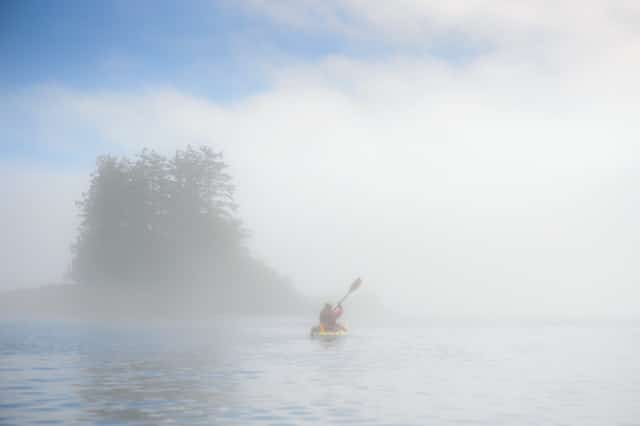
Other weather conditions can also make kayaking more risky. Storms with lightning are a hazard while you are on the water. Colder temperatures also increase the risk of hypothermia which can make kayaking dangerous.
And fog, while it may seem harmless, can be a big risk when kayaking. This is true for two reasons:
- First, it reduces your visibility. If you’re sea kayaking, and paddling in open water you’ll use islands and other landmarks to navigate. Reduced visibility can be disastrous. I remember my first sea-kayaking trip we mistook the sound of one buoy for another when paddling in fog, and we ended up 13 miles off-course, nearly paddling out into the open water of the Atlantic Ocean after lunch.
- Second, it reduces the visibility for other crafts. Kayaks can be hard to see when in large boats on a sunny day. If a larger, fast-moving craft strikes you it can be deadly. Add poor visibility to the mix and you’re taking your life in your hands.
Always Use Kayak Lights at Dusk and After Dark
Failing to use kayak lights in low light conditions can be dangerous. Make sure to have your lights in place at all times and turn them on before the light starts to dim. They’re inexpensive (these ones from Amazon are around $15), and it’s a basic piece of safety equipment that every boater should have.
Know the Danger of Sweepers
A sweeper is a low-hanging branch or another kind of obstacle that comes out across the surface of the body of water. If you get any glimpse of something like this, avoid it by moving as widely around it as you possibly can. Don’t underestimate how dangerous sweepers can be.
Strainers Can Make Kayaking Dangerous
Strainers are different than sweepers but also make kayaking dangerous. They are obstacles that are beneath the water, so you’re not able to see them. They are positioned laterally into the flow of the water. Strainers can be even more hazardous than sweepers. If you’re not careful of strainers and you’re in a more advanced kayaking setting, you’re putting yourself at extremely serious risk.
A strainer might be something as drastic as a complete tree with branches in complex arrangements. When this is the case, debris that is tangled up can be hidden under the water as well. Becoming trapped up against a strainer in certain circumstances may mean that you’re completely trapped and will be unable to stand up to the strength of the water. This will lead to drowning.
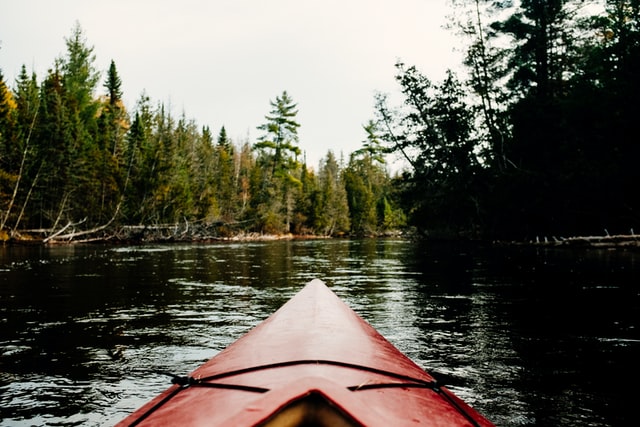
Undercuts are Yet Another Hazard for Kayakers
An undercut is present if there is a part of the bank that has a submerged hollow depression where the water flows underneath the ledge. Mud banks or rock ledges can create significant undercuts. If a kayaker becomes submerged, he can get trapped underneath a shelf. This is a deadly situation.
The most common parts of a river where undercuts will form are on the inside part of a river’s bend. One way to help deal with the potential dangers of undercuts is to always have a partner with you in your kayak and, of course, to wear a life jacket (as you always must as a kayaker).
Is Kayaking Dangerous?
It can be, so always err on the side of caution
Kayaking is a great, relaxing, and enjoyable sport that gets you out in nature. There’s value in the rhythm of paddling, listening to the natural world around you and centering yourself.
If you do kayak, make safety your priority. Kayaking can be dangerous if you don’t take the risks of outdoor water sports seriously.
Being careless in how you prepare to kayak can put you in dangerous circumstances. If you’re new to kayaking, I recommend that you attend some classes and learn paddling technique and everything else you need to know before you embark on your first kayaking adventure.

